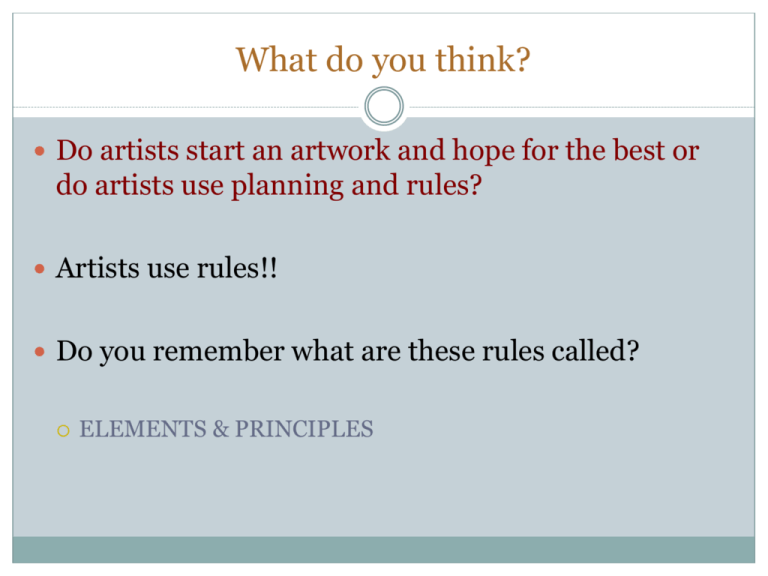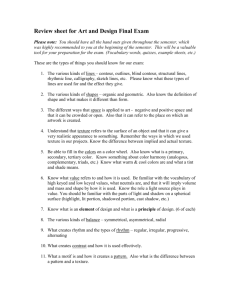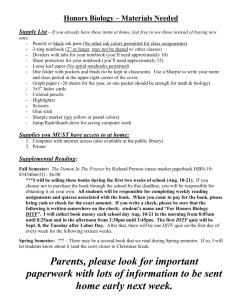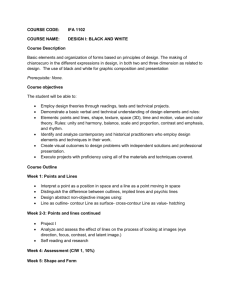Elements of Art
advertisement

What do you think? Do artists start an artwork and hope for the best or do artists use planning and rules? Artists use rules!! Do you remember what are these rules called? ELEMENTS & PRINCIPLES Elements of Design The elements of design are the seven basic building blocks of art & design. Without these building blocks the principles are meaningless. Think of them as “Legos:” parts, pieces or elements of something bigger or whole. We use directions and rules to make something. Principles of Design The basic rules of aesthetics that guide in the organization of elements in a work of art. Without these directions the elements are meaningless. Think of them as “Legos Directions:” Rules or steps to utilize many different, similar and identical elements to create a meaningful, cohesive and understandable piece of artwork. Design Elements Design Principles LINE SHAPE COLOR VALUE TEXTURE SPACE FORM BALANCE VARIETY MOVEMENT CONTRAST EMPHASIS PROPORTION UNITY Line A mark. Lines have thickness, direction, and movement; they can be interrupted and can show emotion in an artwork. Element of Line Contour lines- outline the edges of forms or shapes Gestural lines- indicate action and physical movement Element of Line Element of Line 1. In Sharpie Ink the world “line” 2. Copy the definition of line on the opposite side from the laminated notes 3. To the right of the definition draw and label an Interrupted Line and a Varied Line 4. To the left of the definition draw and label an Organic Line and a Geometric Line Element of Shape When a line curves or corners around and the end connects to the beginning creating a contained area. GEOMETRIC square, triangle, rectangle, rhombus, circle, cone ORGANIC free form shapes, shapes in nature for example: leaves, trees, clouds, animals Element of Shape 1. In Sharpie Ink the world “shape” 2. Copy the definition of shape on the opposite side from the laminated notes 3. To the right of the definition draw and label an example of an organic shape 4. To the left of the definition draw and label an example of a geometric shape Element of Color Color has three properties: 1. The first is: Hue: The name of a color 2. The second property of color is: Value: the lightness or darkness of a hue 3. The third property of color is: Intensity: the purity of a hue; the brightness or dullness of a hue Element of Color 1. In Sharpie Ink the world “color” 2. Copy the definition of color on the opposite side from the laminated notes 3. Use markers to add different colors to the letters of the word Color Hello ART 8 1. Get out your Elements of Art Foldable 2. You need sharpies again too 3. Show me you are ready to begin G 1. Recoja de mi tus Elementos de Arte Plegable 2. Necisitas el marcador delgado, el marcador ancho, tus vocabulario de Arte español/inglés, y tu lápiz 3. Muéstre me cuándo estás listo por favor Value: Tints and Shades Tints-adding the color white Shades- adding the color black Element of Value 1. In Sharpie Ink the world “Value” 2. Copy the definition of Value on the opposite side from the laminated notes 3. Use colored pencils to add different lights and darks to the letters of the word Value 4. Use colored pencils to create at least 4 different tints (lights) to the right 5. Use colored pencils to create at least 4 different shades (darks) to the left Intensity: Neutral Colors Colors that are neither cool nor warm. Neutral colors, called tones, are made by adding two complimentary colors (opposite on the color wheel) together. Element of Texture Textures are the quality of a surface. Actual texture – texture that you can feel with your sense of touch. Implied texture – texture that has been simulated on a drawing or painting to appear as if it has texture. Hatching and Cross Hatching Line can be used to create value and textures Hatching Cross Hatching Stippling Small marks, dots or shapes can be used to create value and textures Stippling Element of Texture 1. In Sharpie Ink the world “texture” and add different textures in each letter 2. Copy the definition of texture on the opposite side from the laminated notes 3. Use thin sharpie add and label an example of hatching and cross hatching to the right To the left, in sharpie add and label an example of stippling and scumbling Element of Space The amount of depth in both 2D and 3D artworks. Around, above, inside, outside, positive or negative. The feeling of space in a drawing or painting is always an illusion. Artists combine the use of light and dark value with other techniques. Linear perspective, and atmospheric perspective create the illusion of space. Linear perspective “Snow in New York” Element of Space 1. In Sharpie Ink the world “space” 2. Copy the definition of space on the opposite side from the laminated notes 3. To the right of the definition draw a vase on a table like you see to the right 4. Label the Positive Space and Negative Space Element of Space 5. To the left of the definition draw a simple road moving into the distance with trees getting smaller and smaller like you see below Element of Form The quality of shape in 3D and 2D artworks. Form describes volume and mass, or the three-dimensional aspects of objects that take up space. Forms can be realistic, abstract, geometric, organic etc. Form is implied in 2D artworks using value. Element of Form 1. In Sharpie Ink the world “form” 2. Copy the definition of form on the opposite side from the laminated notes 3. To the right of the definition draw a simple circle label this: “no form” 4. To the left of the definition draw a sphere using shading label this: “form”





